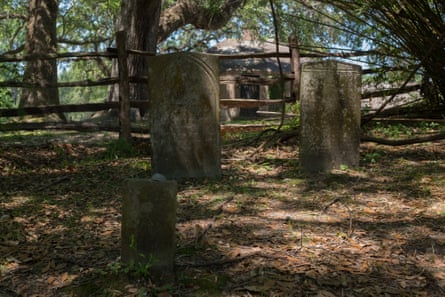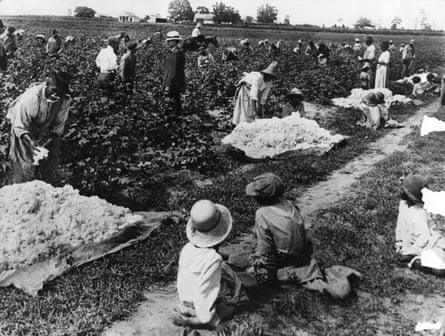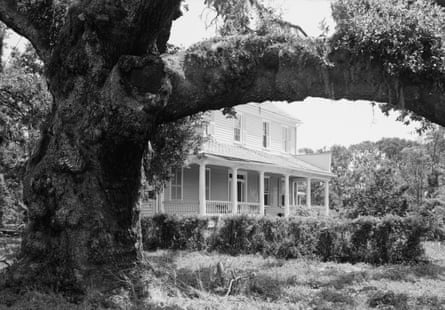It is a picture of southern splendor: a grand oak tree dripping with Spanish moss, a manicured green lawn leading to a pristine pond. It only takes a moment for a group of mostly white tourists to lift their cellphones and snap photos.
Those phones were being returned to pockets and bags when a tour guide explained that the tidy green grass covers a cemetery for the enslaved: the unidentified remains of African men, women and children torn from their homelands lie below the picture-perfect setting.
There are about 375 plantation museums across the US, where the atrocities of slavery compete with the grandeur of plantation living. Recent efforts to bridge this divide are complicated by America’s failure to acknowledge the horrors of slavery. It is 400 years since the first Africans stolen from their homeland were brought to a British colony in North America.
Speaking to the Guardian at the former South Carolina plantation of Middleton Place, Bernard Powers, the director of the College of Charleston’s Center for the Study of Slavery, explained the importance of understanding the scope of life at these sites. “If you fail to understand what happened in the past at these plantations, you don’t understand what the grievances are today,” Powers said.
For some Americans, the word “plantation” brings to mind the horrors of slavery and the white landowners who made it possible. But for many others, it is a symbol of refined living and hospitality – remnants of a more genteel time.

Across the south, housing developments, schools and golf courses include the word “plantation” in their name. And the market for plantation weddings is high.
Over the past two decades, many plantation museums have moved to better incorporate the enslaved experience, in part because of consumer demand for more honest narratives and the growing minority tourism market. Other motivating factors include more honest depictions of slavery in films such as 12 Years a Slave, and the potent force of Black Lives Matter and other social justice movements pushing for America to remedy stark racial disparities that began with slavery.
The shift was apparent at Middleton Place, where visitors are encouraged to take a special Beyond the Fields tour and to visit Eliza’s House, a cottage filled with details about life for the enslaved. The main display inside the cottage includes the names and prices of the 2,800 individuals the Middleton family owned from 1738 to 1865, boiled down to their name, skillset and price: Quash, $50; Toney, blacksmith, $600; Old Hannah, $200.

On the Beyond the Fields tour, the guide relayed a history of slavery that made it sound as though Africans simply arrived in North America, ignoring that men, women and children were held on ships for months at a time. There was no detail about the enslaved people’s interior lives or acts of resistance. Instead, it was mostly a rote description of the work they did. And Powers identified some factual errors.
Powers, who has been a consultant to Middleton Place, said it was important to shake people out of their modern mentality on these tours.
“Slavery was a state of war,” he said. War in the form of learning to read and write when you were forbidden from doing so, or sabotaging the rice fields because you knew how they worked better than your boss. “It was a struggle for survival and to create more living space,” he said.
That Middleton Place, like more and more plantation museums, has a separate tour to speak about the lives of African Americans who lived on the property, represents a step forward and a point of contention. These separate tours can maintain the narrative that the lives of the enslaved were separate from what happened at the Big House, where the master lived. At some places, they cost extra.

Jeff Neale, the director of preservation and interpretation at Middleton Place, said incorporating the African American narrative into the site was an important process that involved balancing the many issues that draw in visitors: its history, its gardens and its decor. “I think it is our responsibility to try and meet all those expectations,” Neale said.
“If you came here [to Charleston] 20 years ago, you probably wouldn’t have heard that word slavery,” he said. “It was kind of the dirty little family secret – we just don’t talk about that.”
This culture of silence has been supported by US public education. Over the past 50 years, lessons about slavery in American schools have gone from largely nonexistent to woefully inadequate. Only 8% of high-school seniors surveyed by the Southern Poverty Law Center (SPLC) could identify slavery as a central part of the civil war, according to a 2017 report.
In a review of 12 popular history textbooks, the SPLC found most failed to mention money being a motivating factor for slavery.
This information gap has also been highlighted by an initiative called Reset led by geographers, historians and other researchers to study inequality in the US tourism industry.
The study found that although plantation tours have improved in how often they speak about the African American experience, there is much room to do better.
Amy Potter, an associate professor of geography at Georgia Southern University, has been leading a Reset project in Charleston, and found it was still possible to visit a plantation without learning about the African American experience.
Starting in 2016, Potter and her team conducted research at four traditional plantations and observed 35 house tours. They found that on all but one of the observed tours, furnishings, family history, architecture and gardens are mentioned more often than slavery.
Slavery was discussed on 70% of those tours, but Potter cautioned that this was often done by discussing the enslaved’s labor, not humanity; as part of a narrative about a loyal slave and a kind master or told in the passive voice.

“There are times when you have the humanizing factor, the use of names, and the visitor is able to meaningfully connect,” Potter said. “But that is not often happening.”
The survey findings have been presented to the plantation owners and will be published in a book in 2020.
The issues faced by the plantations in reckoning fully with their past are part of a broad national debate about the legacy of slavery. This June, Congress held its first hearing about reparations in more than a decade. Democratic 2020 candidates are also being forced to take positions on whether they support reparations.
In 2018, Charleston, where 40% of Africans were brought first before being sold, became one of several cities to formally apologize for slavery. City officials pledged to work to improve racial equality. On an old wharf where slave ships were unloaded, the city is also planning to open the International African American Museum.
These changes come after the summer of 2015 saw nine black people murdered by a 21-year-old white supremacist at Charleston’s historic Emanuel AME church. The murderer, Dylann Roof, the first person in US history sentenced to death for a federal hate crime, visited South Carolina plantations.
One plantation Roof visited, McLeod, is one of two sites known for putting the enslaved at the center of the site. The other is Whitney plantation near New Orleans.
There are no fancy plates at McLeod. Instead, the big house is open for a self-guided tour which emphasizes the close ties between black and white lives on plantations.
On the docent-led tour at McLeod, the guide explained the challenges the newly freed slaves faced after the civil war, while winding through their work sites and cabins. She drew a direct connection between the centuries-long fight for black votes and voter suppression efforts today.

Many people visit McLeod because they are familiar with its reputation, though some unprepared guests leave displeased. “We did not receive a historical [perhaps more like hysteria] relevant or informative tour but depending on your ethnicity, were subjected to a lecture aimed to instil guilt,” said one person in an April 2019 Tripadvisor review.
Despite these complaints, which represent a sliver of Trip Advisor reviews, of the four tours the Guardian took at three plantations, the McLeod plantation was the only one where guests, all white, lined up to tip and thank the guide after it ended.
